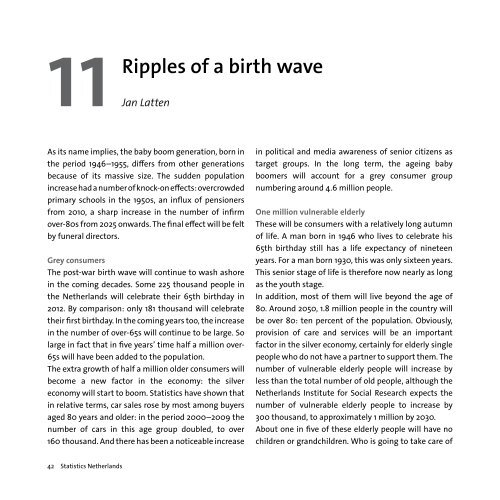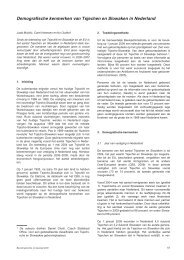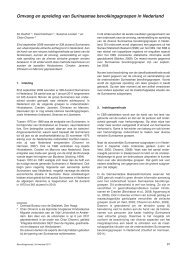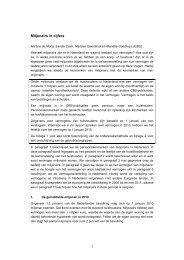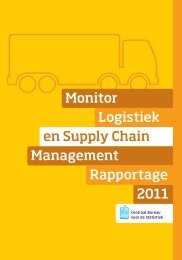Babyboomers in the Netherlands: What the statistics say - Cbs
Babyboomers in the Netherlands: What the statistics say - Cbs
Babyboomers in the Netherlands: What the statistics say - Cbs
Create successful ePaper yourself
Turn your PDF publications into a flip-book with our unique Google optimized e-Paper software.
11<br />
Ripples<br />
of a birth wave<br />
Jan Latten<br />
As its name implies, <strong>the</strong> baby boom generation, born <strong>in</strong><br />
<strong>the</strong> period 1946–1955, differs from o<strong>the</strong>r generations<br />
because of its massive size. The sudden population<br />
<strong>in</strong>crease had a number of knock-on effects: overcrowded<br />
primary schools <strong>in</strong> <strong>the</strong> 1950s, an <strong>in</strong>flux of pensioners<br />
from 2010, a sharp <strong>in</strong>crease <strong>in</strong> <strong>the</strong> number of <strong>in</strong>firm<br />
over-80s from 2025 onwards. The f<strong>in</strong>al effect will be felt<br />
by funeral directors.<br />
Grey consumers<br />
The post-war birth wave will cont<strong>in</strong>ue to wash ashore<br />
<strong>in</strong> <strong>the</strong> com<strong>in</strong>g decades. Some 225 thousand people <strong>in</strong><br />
<strong>the</strong> Ne<strong>the</strong>rlands will celebrate <strong>the</strong>ir 65th birthday <strong>in</strong><br />
2012. By comparison: only 181 thousand will celebrate<br />
<strong>the</strong>ir first birthday. In <strong>the</strong> com<strong>in</strong>g years too, <strong>the</strong> <strong>in</strong>crease<br />
<strong>in</strong> <strong>the</strong> number of over-65s will cont<strong>in</strong>ue to be large. So<br />
large <strong>in</strong> fact that <strong>in</strong> five years’ time half a million over-<br />
65s will have been added to <strong>the</strong> population.<br />
The extra growth of half a million older consumers will<br />
become a new factor <strong>in</strong> <strong>the</strong> economy: <strong>the</strong> silver<br />
economy will start to boom. Statistics have shown that<br />
<strong>in</strong> relative terms, car sales rose by most among buyers<br />
aged 80 years and older: <strong>in</strong> <strong>the</strong> period 2000–2009 <strong>the</strong><br />
number of cars <strong>in</strong> this age group doubled, to over<br />
160 thousand. And <strong>the</strong>re has been a noticeable <strong>in</strong>crease<br />
<strong>in</strong> political and media awareness of senior citizens as<br />
target groups. In <strong>the</strong> long term, <strong>the</strong> age<strong>in</strong>g baby<br />
boomers will account for a grey consumer group<br />
number<strong>in</strong>g around 4.6 million people.<br />
One million vulnerable elderly<br />
These will be consumers with a relatively long autumn<br />
of life. A man born <strong>in</strong> 1946 who lives to celebrate his<br />
65th birthday still has a life expectancy of n<strong>in</strong>eteen<br />
years. For a man born 1930, this was only sixteen years.<br />
This senior stage of life is <strong>the</strong>refore now nearly as long<br />
as <strong>the</strong> youth stage.<br />
In addition, most of <strong>the</strong>m will live beyond <strong>the</strong> age of<br />
80. Around 2050, 1.8 million people <strong>in</strong> <strong>the</strong> country will<br />
be over 80: ten percent of <strong>the</strong> population. Obviously,<br />
provision of care and services will be an important<br />
factor <strong>in</strong> <strong>the</strong> silver economy, certa<strong>in</strong>ly for elderly s<strong>in</strong>gle<br />
people who do not have a partner to support <strong>the</strong>m. The<br />
number of vulnerable elderly people will <strong>in</strong>crease by<br />
less than <strong>the</strong> total number of old people, although <strong>the</strong><br />
Ne<strong>the</strong>rlands Institute for Social Research expects <strong>the</strong><br />
number of vulnerable elderly people to <strong>in</strong>crease by<br />
300 thousand, to approximately 1 million by 2030.<br />
About one <strong>in</strong> five of <strong>the</strong>se elderly people will have no<br />
children or grandchildren. Who is go<strong>in</strong>g to take care of<br />
42 Statistics Ne<strong>the</strong>rlands


